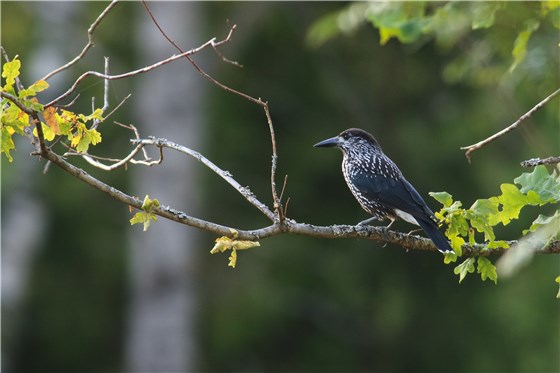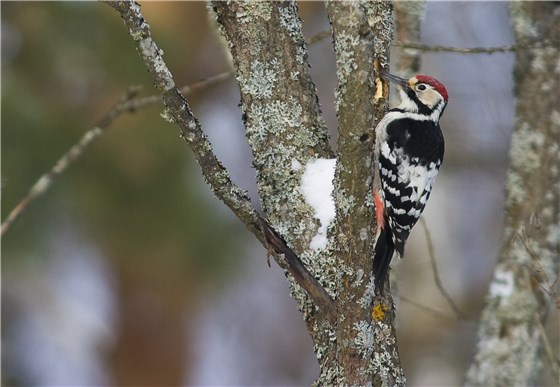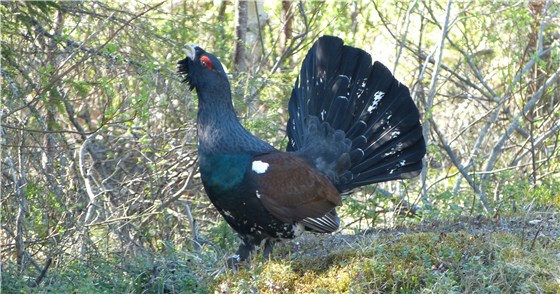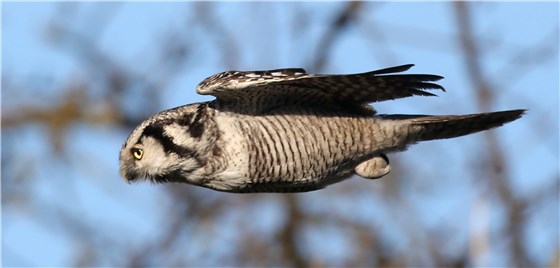Estonia Migration Special
For details on our current birdwatching trips in North Wales, across the UK and further afield, please click on the following link to go to our new website: http://www.birdwatchingtrips.co.uk/tours
Come and join us at BirdwatchingTrips with The Biggest Twitch for the best birdwatching trips in North Wales, the UK and beyond!

Nutcracker: high on our most wanted list in Estonia, photo by Sven Zacek
Estonia in the autumn is a magnificent destination for the birdwatcher who wants to see spectacular bird migration including raptors, cranes, seaduck, finches, thrushes and more, as well as special forest species such as woodpeckers and forest grouse, plus the added excitement of eastern rarities and even some mammals. In western Estonia, wetlands are always full of life in the autumn. In October, thousands of ducks, geese and cranes use these wetlands as their last feeding and roosting grounds before their final migration to their wintering sites. The sight of tens of thousands of common birds like Chaffinch and Brambling pouring overhead is very impressive and these can include large numbers of Goldcrests, Northern Wheatears and Common Starlings. To see bird migration on this scale is TRULY spectacular!

White-backed Woodpecker, Estonia has lots of peckers to enjoy, photo by Sven Zacek
We will be looking for the following birds:
Golden Eagle, White-tailed Eagle, Common Crane (hundreds), White-fronted Geese and Bean Geese, tens of thousands of Barnacle Geese, peak autumn migration of songbirds, waders and waterfowl, Goshawk, Peregrine Falcon, Black Grouse, White-backed Woodpecker, Three-toed Woodpecker, Black Woodpecker, Lesser Spotted Woodpecker, Grey-headed Woodpecker, Yellow-browed Warbler, Nutcracker, Crested Tit, Long-tailed Tit, Bearded Tit, Lapland Bunting. We also have a chance of seeing Hazel Grouse and Capercaillie.

Male Capercaillie, a magnificent bird
Mammals could include:
Wild Boar, Raccoon Dog, Red Fox, Elk, Roe deer and Red Deer.
Join us on our exciting 5-day birdwatching tour focusing on the spectacular bird migration in Western Estonia!

Visiting Estonia is like travelling back in time, to meadows packed with wildflowers and birds
Itinerary
Day 1: Our tour begins at Tallinn International Airport. We travel to Saaremaa island where we check in to our very comfortable hotel before exploring the many shallow bays, coastal lagoons and marshlands in the area. Overnight in Saaremaa.
Day 2: We spend the day exploring Saaremaa island. First we target the Sõrve Peninsula and Sääre Spit. This is over 50 km long stretching south-westerly from the rest of the island. This is the last point before take-off for landbirds as well as providing excellent points for watching seabirds on the surrounding open sea and islets. This is the best place in the country to watch skuas, waders, and diving ducks. The Sõrve is famous for its frequent sightings of rare birds and, especially during autumn migration, expect the unexpected should be our watchword. Migrant raptors can be seen in good numbers, especially Sparrowhawk, buzzards, harriers, falcons as well as Lesser Spotted and other eagle species.
At its peak, the migration of passerines can reach huge numbers and it is an unforgettable experience to follow the passage of hundreds of thousands of Chaffinches, Bramblings and Siskins from our watchpoint on the top of an old Soviet military fort. Saaremaa is also a wonderful location for catching up with Common Cranes and we hope to see good numbers of these charismatic birds around the island. We may also visit a bird observatory where we may have some very close encounters indeed with migrants – perhaps even including some eastern rarities. Overnight in Saaremaa.
Day 3: After breakfast we will continue our birding on Saaremaa island visiting sites along the Loode coast and Lõu Bay, and we may also have a short visit to the Sõrve Bird Observatory on the southernmost tip of the island. On our way back to the mainland we will make a short stop at the Suur Väin Straits which can be a good place for flocks of seaduck. We arrive at Virtsu harbour later in the afternoon and drive to north-west Estonia. After checking in to our lovely hotel we will visit the adjacent Haapsalu town. This area has many shallow sheltered bays, coastal lagoons, marshlands and reedbeds which are important staging posts for large numbers of waterbirds. Haapsalu is a remarkable town in that the town centre and the coastal promenade offer spectacular views over Haapsalu bay where tens of thousands of Goldeneye, Coot, Scaup, Tufted Duck, Wigeon and Smew may be on view. Dinner here is often interrupted by sightings of White-tailed Eagles, cranes, swans, waders or other exiting birds! Overnight in Haapsalu.
Day 4: We spend the day exploring this north-easterly corner of Estonia, starting from the most north-easterly point of all, the Põõsaspea. This small north-stretching spit is situated at the migratory crossroads where masses of waterbirds coming from the Bothnian and the Finnish Bays meet. This is one of the best places to witness Arctic waterbird migration. Hundreds of thousands of Long-Tailed Ducks, Common Scoters and geese can be seen during the peak of migration. This place is also famous for its diver migration: as many as two thousand Black-throated and Red-Throated Divers can be seen on daily basis, and White-billed Diver is frequently seen. In contrast, we also will visit an area of heathland and forest where we will be looking for Black Grouse, Capercaillie, Hazel Grouse, Wryneck, and some exciting woodpecker species.
In the afternoon, following our coastal pursuit of migratory waterbirds we visit Matsalu National Park. This is the most famous bird area in Estonia, renowned as one of the most important breeding and stop-over areas for waterfowl and waders in the whole of Northern Europe. Over 40 sq km, this reserve consists of large open floodplains and coastal meadows, riparian and coastal woodlands, river delta and marshlands and the shallow Matsalu Bay with 3,000 ha of reedbeds and numerous islands with seven birdwatching towers around it. This diversity makes this reserve so attractive as a migratory staging post for vast numbers of coastal and waterbirds. Matsalu Bay is typically dotted with white spots as up to 20,000 thousand Whooper and Bewick’s Swans rest here, as well as tens of thousands of Goldeneye, Pochard, Wigeon, Teal and waders. In addition, several thousands of Barnacle, Bean, Graylag and White-fronted Geese feed on the grass of the local meadows and fields, and the very rare Lesser White-fronted Goose can be found amongst them. Seeing wildfowl and waders in such staggering numbers is an unforgettable experience. Overnight in Haapsalu.
Days 5: After breakfast we will drive to Puise peninsula and explore a variety of coastal habitats. We also visit Haeska watching tower. This region holds the record for the highest ever recorded daylist of bird species in Northern Europe during a visit in May so even in October we can expect to enjoy plenty of birds. On our way back to Tallinn, we have time for a short visit to some old growth coniferous and mixed forest to look for any forest species we may have missed earlier. We return to Tallinn airport by late afternoon for our homeward flights, where our tour ends.

Beautiful Haapsalu
Our holiday includes 4 nights’ accommodation on a fully inclusive basis, ie breakfast, lunch and dinner, guiding by Alan and Ruth and a expert English-speaking local guide throughout the trip, transport in a minibus during the tour, entrance fees to all reserves, use of our field guide and Leica telescopes, and individual checklists.
The cost of the trip is £950 per person for a maximum of six participants, based on two people sharing an ensuite twin or double room. A single room supplement of £150 for the trip will apply. This will be a small group to ensure everyone has individual attention and the best chance of catching up with some of the very special forest birds.
The cost does not include: international flights, travel to and from your UK airport, personal travel insurance, drinks, and any items of a personal nature.

Grey Partridge like many farmland birds are common in Estonia
To reserve your place on this tour or for more details, please email us on
info@thebiggesttwitch.com as soon as possible. Good accommodation in the areas we will be visiting is very limited and we need to book quickly to ensure our places. We look forward to hearing from you and sharing the amazing spectacle of autumn migration in Estonia with you!

Charismatic Hawk Owl, photo copyright of (Press photographer) Andreas Kretschel, Hohenstein-Erstthal/Germany
2013 saw the biggest invasion of Hawk Owls to take place in Estonia for many years. The first birds started to appear in late August – nearly two months earlier than usual so, who knows, with luck we may catch up with this stunning northern owl during our trip.
Hope you can join us looking for this and many other exciting birds in Estonia. We look forward to hearing from you!
info@thebiggesttwitch.com